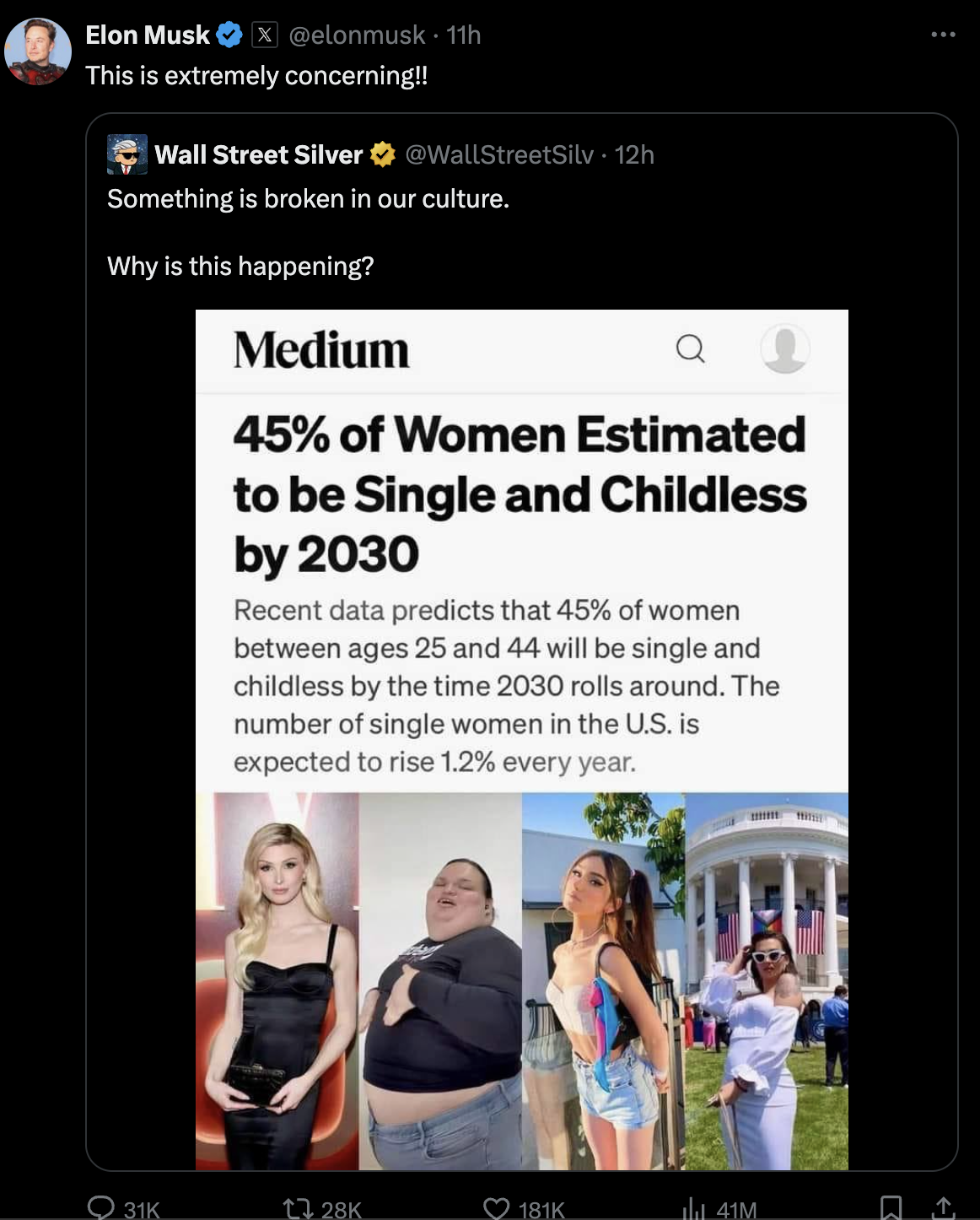Here's a breakdown of the provided text and image: **Summary:** The image shows a Twitter post by Elon Musk expressing concern about a Medium article predicting that 45% of women aged 25-44 in the U.S. will be single and childless by 2030, with an annual increase of 1.2%. The Medium article excerpt is included in the image. The tweet also includes a comment from "Wall Street Silver" echoing this concern and questioning the reasons behind it. The image also features a collage of four photos of young women, seemingly chosen to illustrate diverse appearances. **Document type:** Social media post (Twitter) sharing an article from Medium and expressing an opinion. **Claims:** * **Main Claim:** 45% of women aged 25-44 in the U.S. will be single and childless by 2030. * **Supporting Claim:** The number of single women in the U.S. is expected to rise by 1.2% annually. **Implications:** The claims imply a societal shift towards fewer women having children and/or getting married. The accompanying emotional commentary from Elon Musk and Wall Street Silver suggests a negative societal interpretation of this trend. This interpretation could range from concern about declining birth rates to more concerning views about women's choices, societal values, etc. **Are the claims obviously false? How do we know?** It's impossible to definitively say if the claim is false without access to the original data source used by the Medium article. However, there are significant reasons for skepticism: * **Lack of Source:** The image only provides a summary and lacks a link to the underlying data or methodology. * **Imprecise Prediction:** Predicting social trends this far into the future is inherently difficult and uncertain. Many external factors can impact fertility rates, marriage rates, etc. * **Selection Bias (potential):** The photos included might be selected to reinforce a certain negative perception of the predicted trend. **Biases:** * **Confirmation Bias:** Both Elon Musk and Wall Street Silver seem to be expressing pre-existing concerns about societal trends, and this article may confirm existing biases. This is indicated by the phrasing "Something is broken in our culture." * **Anti-feminist Bias (potential):** Depending on the interpretation, the framing of the article and the accompanying emotional response could be seen as expressing anti-feminist sentiments, suggesting a negative judgement of women's choices regarding motherhood and marriage. The collage of images contributes to this by emphasizing the appearance of the women rather than their life circumstances. * **Malthusian Bias (potential):** There's a subtle hint of Malthusian thinking – a concern about population decline or an overly negative interpretation of potential population shifts. It is crucial to treat this information with caution due to lack of verification and potential biases. The lack of a source for the claimed data makes the assessment of the claims themselves unreliable.
Info Sleuth
What the user found on the internet:
elon musk

What to tell the user about it:
This Twitter post by Elon Musk shares a Medium article predicting that 45% of American women aged 25-44 will be single and childless by 2030, increasing by 1.2% annually. The post includes commentary expressing concern about this trend. While the prediction is presented as factual, its reliability is questionable due to the absence of a source for the data and the inherent difficulty in predicting long-term social trends. Consider the possibility of bias, as both Elon Musk and the commenter seem to express pre-existing concerns that may be influencing their interpretation. To gain a clearer understanding, it's essential to find and critically evaluate the original source of the Medium article's statistics, looking for details on their methodology and data sources. Also, consider that the prediction focuses on a specific demographic and doesn't represent the entirety of women's experiences.
Suggested queries to learn more: